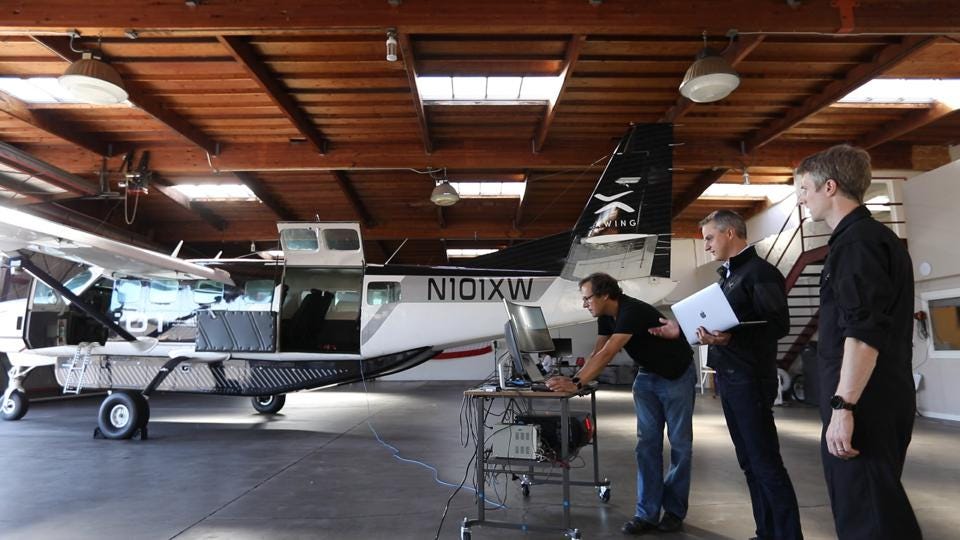TECHNOLOGY
Pros and Cons of Autonomous Flight Technology

Autonomous flight technology has been making headlines in recent years, as major aerospace companies and start-ups race to develop self-flying aircraft.
While the technology has the potential to revolutionize the aviation industry, it also raises a number of concerns and questions about safety, security, and ethical implications. In this article, we will examine the pros and cons of autonomous flight technology, and look at some of the current and future applications of this cutting-edge technology.
What is Autonomous Flight Technology?

Autonomous flight technology refers to the use of artificial intelligence, machine learning algorithms, and other advanced technologies to develop aircraft that can fly without human intervention. The development of autonomous flight technology is being driven by the need to increase the efficiency, safety, and sustainability of air transportation, as well as the military’s need for unmanned aerial vehicles (UAVs) for surveillance, reconnaissance, and attack missions.
Pros of Autonomous Flight Technology

Autonomous flight technology can increase efficiency and productivity. Here are the most important advantages of autonomous flight technology:
1. Increased Safety
One of the primary advantages of autonomous flight technology is enhanced safety. Autonomous aircraft can be programmed to follow safe flight paths and procedures, reducing the risk of human error that can result in accidents. For example, self-flying aircraft can be programmed to avoid turbulence, storms, and other hazardous weather conditions, making air travel safer for passengers.
2. Improved Efficiency
Another advantage of autonomous flight technology is improved efficiency. Autonomous aircraft can fly more efficiently than manned aircraft, reducing fuel consumption and emissions. They can also fly more precise routes, reducing travel time and reducing the carbon footprint of air transportation.
3. Cost Savings
In addition to increased safety and improved efficiency, autonomous flight technology can also lead to cost savings. Self-flying aircraft can fly more hours than manned aircraft, reducing the need for maintenance and crew costs. They can also fly more precise routes, reducing fuel consumption and further reducing costs.
4. Military Applications
The military also has a keen interest in autonomous flight technology. Unmanned aerial vehicles (UAVs) can be used for surveillance, reconnaissance, and attack missions, reducing the risk to human pilots. They can also be used for dangerous and difficult missions, such as flying in hazardous environments or flying in conflict zones.
Cons of Autonomous Flight Technology

UAVs equipped with cameras and other sensors can collect and transmit data, potentially violating individual privacy rights. Here are some major cons of autonomous flight technology:
1. Technical Challenges
One of the biggest challenges of autonomous flight technology is the technical difficulties involved in developing self-flying aircraft. The technology is still in its early stages, and there is much work to be done to refine the algorithms and systems used to control autonomous aircraft. There are also concerns about the reliability and safety of these systems, and how they will perform in real-world conditions.
2. Privacy and Security
Another concern with autonomous flight technology is privacy and security. Autonomous aircraft can be equipped with cameras, sensors, and other surveillance technologies, raising questions about privacy and security. There are also concerns about the potential for malicious use of autonomous aircraft, such as for espionage or other criminal activities.
3. Job Losses
The development of autonomous flight technology also raises concerns about job losses in the aviation industry. As self-flying aircraft become more common, there may be a reduced need for human pilots, flight attendants, and other aviation professionals. This could lead to significant job losses in the aviation industry, and a need for workers to be retrained for new careers.
4. Ethical Implications
Finally, the development of autonomous flight technology raises important ethical questions about the use of artificial intelligence and machine learning algorithms in the aviation industry. There are concerns about the potential for bias and discrimination in the algorithms used to control autonomous aircraft, as well as questions about accountability in the event of accidents or other incidents.
What’s Next for Autonomous Flight Technology?
The future of autonomous flight technology looks promising, with many exciting developments and advancements on the horizon. Here are some of the trends and innovations that we can expect in the near future:
-
Increased Integration with Other Technologies: Autonomous flight technology will continue to integrate with other technologies, such as artificial intelligence, machine learning, and the Internet of Things (IoT), to enhance their capabilities and performance. For example, UAVs equipped with AI algorithms will be able to make more informed decisions, operate more efficiently, and adapt to changing conditions.
-
Wider Adoption in Commercial Applications: We can expect to see wider adoption of UAVs in commercial applications, such as delivery services, agriculture, and construction. As regulations and infrastructure evolve to support their use, UAVs will become increasingly integrated into these industries, providing significant benefits in terms of efficiency, cost-effectiveness, and safety.
-
Expansion into New Applications: Autonomous flight technology will continue to expand into new applications, such as environmental monitoring, wildlife tracking, and search and rescue operations. UAVs equipped with specialized sensors and cameras will be able to gather valuable data and provide new insights into various fields, opening up new opportunities and possibilities.
-
Development of Autonomous Flight Networks: The development of autonomous flight networks will enable UAVs to operate more efficiently, safely, and effectively. This will involve the development of dedicated air traffic management systems, communication networks, and regulations to support the widespread use of UAVs.
-
Advancements in Battery Technology: Finally, we can expect to see advancements in battery technology, which will be critical for the continued growth and success of autonomous flight technology. Improved battery technology will enable UAVs to fly for longer periods, reducing downtime and increasing their efficiency and productivity.
In conclusion, the future of autonomous flight technology is bright, with many exciting developments and advancements on the horizon. As the technology continues to evolve and mature, we can expect to see wider adoption in various industries and new applications, providing significant benefits and opportunities for society as a whole.
TECHNOLOGY
Next-gen chips, Amazon Q, and speedy S3

AWS re:Invent, which has been taking place from November 27 and runs to December 1, has had its usual plethora of announcements: a total of 21 at time of print.
Perhaps not surprisingly, given the huge potential impact of generative AI – ChatGPT officially turns one year old today – a lot of focus has been on the AI side for AWS’ announcements, including a major partnership inked with NVIDIA across infrastructure, software, and services.
Yet there has been plenty more announced at the Las Vegas jamboree besides. Here, CloudTech rounds up the best of the rest:
Next-generation chips
This was the other major AI-focused announcement at re:Invent: the launch of two new chips, AWS Graviton4 and AWS Trainium2, for training and running AI and machine learning (ML) models, among other customer workloads. Graviton4 shapes up against its predecessor with 30% better compute performance, 50% more cores and 75% more memory bandwidth, while Trainium2 delivers up to four times faster training than before and will be able to be deployed in EC2 UltraClusters of up to 100,000 chips.
The EC2 UltraClusters are designed to ‘deliver the highest performance, most energy efficient AI model training infrastructure in the cloud’, as AWS puts it. With it, customers will be able to train large language models in ‘a fraction of the time’, as well as double energy efficiency.
As ever, AWS offers customers who are already utilising these tools. Databricks, Epic and SAP are among the companies cited as using the new AWS-designed chips.
Zero-ETL integrations
AWS announced new Amazon Aurora PostgreSQL, Amazon DynamoDB, and Amazon Relational Database Services (Amazon RDS) for MySQL integrations with Amazon Redshift, AWS’ cloud data warehouse. The zero-ETL integrations – eliminating the need to build ETL (extract, transform, load) data pipelines – make it easier to connect and analyse transactional data across various relational and non-relational databases in Amazon Redshift.
A simple example of how zero-ETL functions can be seen is in a hypothetical company which stores transactional data – time of transaction, items bought, where the transaction occurred – in a relational database, but use another analytics tool to analyse data in a non-relational database. To connect it all up, companies would previously have to construct ETL data pipelines which are a time and money sink.
The latest integrations “build on AWS’s zero-ETL foundation… so customers can quickly and easily connect all of their data, no matter where it lives,” the company said.
Amazon S3 Express One Zone
AWS announced the general availability of Amazon S3 Express One Zone, a new storage class purpose-built for customers’ most frequently-accessed data. Data access speed is up to 10 times faster and request costs up to 50% lower than standard S3. Companies can also opt to collocate their Amazon S3 Express One Zone data in the same availability zone as their compute resources.
Companies and partners who are using Amazon S3 Express One Zone include ChaosSearch, Cloudera, and Pinterest.
Amazon Q
A new product, and an interesting pivot, again with generative AI at its core. Amazon Q was announced as a ‘new type of generative AI-powered assistant’ which can be tailored to a customer’s business. “Customers can get fast, relevant answers to pressing questions, generate content, and take actions – all informed by a customer’s information repositories, code, and enterprise systems,” AWS added. The service also can assist companies building on AWS, as well as companies using AWS applications for business intelligence, contact centres, and supply chain management.
Customers cited as early adopters include Accenture, BMW and Wunderkind.
Want to learn more about cybersecurity and the cloud from industry leaders? Check out Cyber Security & Cloud Expo taking place in Amsterdam, California, and London. Explore other upcoming enterprise technology events and webinars powered by TechForge here.
TECHNOLOGY
HCLTech and Cisco create collaborative hybrid workplaces

Digital comms specialist Cisco and global tech firm HCLTech have teamed up to launch Meeting-Rooms-as-a-Service (MRaaS).
Available on a subscription model, this solution modernises legacy meeting rooms and enables users to join meetings from any meeting solution provider using Webex devices.
The MRaaS solution helps enterprises simplify the design, implementation and maintenance of integrated meeting rooms, enabling seamless collaboration for their globally distributed hybrid workforces.
Rakshit Ghura, senior VP and Global head of digital workplace services, HCLTech, said: “MRaaS combines our consulting and managed services expertise with Cisco’s proficiency in Webex devices to change the way employees conceptualise, organise and interact in a collaborative environment for a modern hybrid work model.
“The common vision of our partnership is to elevate the collaboration experience at work and drive productivity through modern meeting rooms.”
Alexandra Zagury, VP of partner managed and as-a-Service Sales at Cisco, said: “Our partnership with HCLTech helps our clients transform their offices through cost-effective managed services that support the ongoing evolution of workspaces.
“As we reimagine the modern office, we are making it easier to support collaboration and productivity among workers, whether they are in the office or elsewhere.”
Cisco’s Webex collaboration devices harness the power of artificial intelligence to offer intuitive, seamless collaboration experiences, enabling meeting rooms with smart features such as meeting zones, intelligent people framing, optimised attendee audio and background noise removal, among others.
Want to learn more about cybersecurity and the cloud from industry leaders? Check out Cyber Security & Cloud Expo taking place in Amsterdam, California, and London. Explore other upcoming enterprise technology events and webinars powered by TechForge here.
TECHNOLOGY
Canonical releases low-touch private cloud MicroCloud

Canonical has announced the general availability of MicroCloud, a low-touch, open source cloud solution. MicroCloud is part of Canonical’s growing cloud infrastructure portfolio.
It is purpose-built for scalable clusters and edge deployments for all types of enterprises. It is designed with simplicity, security and automation in mind, minimising the time and effort to both deploy and maintain it. Conveniently, enterprise support for MicroCloud is offered as part of Canonical’s Ubuntu Pro subscription, with several support tiers available, and priced per node.
MicroClouds are optimised for repeatable and reliable remote deployments. A single command initiates the orchestration and clustering of various components with minimal involvement by the user, resulting in a fully functional cloud within minutes. This simplified deployment process significantly reduces the barrier to entry, putting a production-grade cloud at everyone’s fingertips.
Juan Manuel Ventura, head of architectures & technologies at Spindox, said: “Cloud computing is not only about technology, it’s the beating heart of any modern industrial transformation, driving agility and innovation. Our mission is to provide our customers with the most effective ways to innovate and bring value; having a complexity-free cloud infrastructure is one important piece of that puzzle. With MicroCloud, the focus shifts away from struggling with cloud operations to solving real business challenges” says
In addition to seamless deployment, MicroCloud prioritises security and ease of maintenance. All MicroCloud components are built with strict confinement for increased security, with over-the-air transactional updates that preserve data and roll back on errors automatically. Upgrades to newer versions are handled automatically and without downtime, with the mechanisms to hold or schedule them as needed.
With this approach, MicroCloud caters to both on-premise clouds but also edge deployments at remote locations, allowing organisations to use the same infrastructure primitives and services wherever they are needed. It is suitable for business-in-branch office locations or industrial use inside a factory, as well as distributed locations where the focus is on replicability and unattended operations.
Cedric Gegout, VP of product at Canonical, said: “As data becomes more distributed, the infrastructure has to follow. Cloud computing is now distributed, spanning across data centres, far and near edge computing appliances. MicroCloud is our answer to that.
“By packaging known infrastructure primitives in a portable and unattended way, we are delivering a simpler, more prescriptive cloud experience that makes zero-ops a reality for many Industries.“
MicroCloud’s lightweight architecture makes it usable on both commodity and high-end hardware, with several ways to further reduce its footprint depending on your workload needs. In addition to the standard Ubuntu Server or Desktop, MicroClouds can be run on Ubuntu Core – a lightweight OS optimised for the edge. With Ubuntu Core, MicroClouds are a perfect solution for far-edge locations with limited computing capabilities. Users can choose to run their workloads using Kubernetes or via system containers. System containers based on LXD behave similarly to traditional VMs but consume fewer resources while providing bare-metal performance.
Coupled with Canonical’s Ubuntu Pro + Support subscription, MicroCloud users can benefit from an enterprise-grade open source cloud solution that is fully supported and with better economics. An Ubuntu Pro subscription offers security maintenance for the broadest collection of open-source software available from a single vendor today. It covers over 30k packages with a consistent security maintenance commitment, and additional features such as kernel livepatch, systems management at scale, certified compliance and hardening profiles enabling easy adoption for enterprises. With per-node pricing and no hidden fees, customers can rest assured that their environment is secure and supported without the expensive price tag typically associated with cloud solutions.
Want to learn more about cybersecurity and the cloud from industry leaders? Check out Cyber Security & Cloud Expo taking place in Amsterdam, California, and London. Explore other upcoming enterprise technology events and webinars powered by TechForge here.
-

 MARKETING6 days ago
MARKETING6 days agoA Recap of Everything Marketers & Advertisers Need to Know
-

 PPC5 days ago
PPC5 days agoHow the TikTok Algorithm Works in 2024 (+9 Ways to Go Viral)
-

 MARKETING4 days ago
MARKETING4 days agoHow To Protect Your People and Brand
-

 SEARCHENGINES5 days ago
SEARCHENGINES5 days agoGoogle Started Enforcing The Site Reputation Abuse Policy
-

 SEO5 days ago
SEO5 days agoBlog Post Checklist: Check All Prior to Hitting “Publish”
-

 SEO3 days ago
SEO3 days agoHow to Use Keywords for SEO: The Complete Beginner’s Guide
-

 PPC6 days ago
PPC6 days agoHow to Craft Compelling Google Ads for eCommerce
-

 MARKETING5 days ago
MARKETING5 days agoElevating Women in SEO for a More Inclusive Industry














You must be logged in to post a comment Login